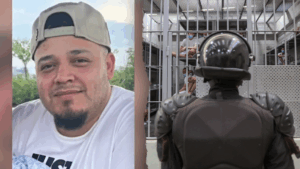AI Analysis of World Trade Center Collapse Shows Tops of Buildings Could NOT Have Caused Progressive Collapse

The first questionable premise of the official narrative of the World Trade Center Collapse is that the fire caused by the jet fuel weakened the support beams enough to allow a simultaneous failure of the structure of the floors affected by the crash. This is a dubious claim since the melting point of steel is 1000 degrees higher than the temperature at which jet fuel burns, but let’s assume that that happened. The theory is that all the beams gave way and the resulting energy from the falling top portion of the building was enough to start a progressive collapse of each building all the way down.

But is this even physically possible? We asked AI and here was the analysis for WTC 1:
Key Parameters:
Let’s revise the scenario by adding 236 additional steel columns to the 47 core columns, where these additional columns are designed to take half of the gravitational load of the structure. The revised question is whether the building can withstand the energy from the top section falling 4 meters onto the bottom section, given this new column arrangement.
Recap of Scenario:
- Total building height: 417 meters
- Top section (falling part) height: 54 meters
- Fall height: 4 meters
- Building mass: 450,000,000 kilograms
- Number of core columns: 47
- Additional columns: 236 (designed to take half of the gravitational load)
- Steel types: A36 steel or ASTM A242 (Corten steel)
Step 1: Estimate the mass of the falling section
The top section is 54 meters tall. Assuming the mass is uniformly distributed, the fraction of the total mass that belongs to the top section is:

So, the mass of the falling section is:

Step 2: Calculate the velocity of the falling section
The section falls from a height of 4 meters. Using the free-fall velocity formula:

Where:
- g=9.8 m/s2g = 9.8 \, \text{m/s}^2g=9.8m/s2 (acceleration due to gravity),
- h=4 metersh = 4 \, \text{meters}h=4meters (fall height).

Step 3: Calculate the kinetic energy of the falling section
The kinetic energy (KE) of the falling section is:

Substituting m=58,275,000kg and 𝑣 = 8.86 m/s v=8.86m/s

Step 4: Estimate the impact force
Assume a deceleration distance of 1 meter for the impact. Using the work-energy principle:

Where:
- F impact is the average impact force,
- d=1meter (deceleration distance)
- KE=2.29×109Joules.
Thus, the impact force is:

Step 5: Load distribution between core and additional columns
The 236 additional columns are designed to take half of the gravitational load. So, we assume they will also take half of the impact force. Therefore, the 47 core columns and the 236 additional columns each take half of the total impact force:

Step 6: Distribute the force across the columns
For the 47 core columns:
The force per core column is:

For the 236 additional columns:
The force per additional column is:

Step 7: Convert the force to load (weight) per column
For the 47 core columns:
Convert the force to a load in metric tons:Load per core column=2.44×1079.8≈2,490 metric tons per core column\text{Load per core column} = \frac{2.44 \times 10^7}{9.8} \approx 2,490 \, \text{metric tons per core column}Load per core column=9.82.44×107≈2,490metric tons per core column

For the 236 additional columns:
Convert the force to a load in metric tons:Load per additional column=4.85×1069.8≈495 metric tons per additional column\text{Load per additional column} = \frac{4.85 \times 10^6}{9.8} \approx 495 \, \text{metric tons per additional column}Load per additional column=9.84.85×106≈495metric tons per additional column

Step 8: Compare with the column capacity
From previous calculations, we know the approximate load-bearing capacities of A36 steel and ASTM A242 (Corten) steel columns:
- A36 steel column capacity: 3,827 metric tons per column
- ASTM A242 (Corten) steel column capacity: 5,280 metric tons per column
Step 9: Evaluate the Scenario
For the 47 core columns:
- The load per core column is 2,490 metric tons, which is well within the capacity of both A36 steel (3,827 metric tons) and ASTM A242 (Corten) steel (5,280 metric tons).
For the 236 additional columns:
- The load per additional column is 495 metric tons, which is significantly less than the capacity of either A36 steel or ASTM A242 (Corten) steel, both of which are more than capable of supporting this load.
Conclusion:
With 47 core columns and 236 additional columns, where the additional columns are designed to take half of the gravitational load, both A36 steel and ASTM A242 (Corten) steel columns should be able to withstand the impact of the 54-meter top section falling 4 meters. The load on each column, even in the core columns, is within the capacity limits of both types of steel, meaning the building would likely remain standing and resist collapse in this scenario.
This is what countless engineers have attested to:
The only thing that could explain the perfect collapse in the footprint of each building is engineered collapse in which the steel beams were all cut simultaneously.





